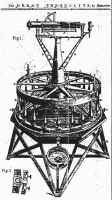|
 Article taken from "Backsights"
Magazine published by Surveyors Historical Society
Article taken from "Backsights"
Magazine published by Surveyors Historical Society
|
 The
evolution of the theodolite began with the description of the instrument
included within the book Pantometria, by Leonard Diggs in 1571.
After two centuries of adaptations and improvements, the theodolite reached a
final basic form in the late 18th century. It was during this time period
that a very unique theodolite was built. In 1775 Jesse Ramsden,
(1735-1800) a most innovative London instrument maker, completed his circular
dividing engine. This engine enabled much more accurate divisions than the
previous laborious and tedious means of manually dividing circles. In the
year 1782, it was proposed by British cartographers that the relative locations
of both the Royal Observatory in Greenwich England and the Observatory in Paris
France, be tied together by means of triangulation, and then the whole of
Britain be divided into great triangles. Jesse Ramsden was appointed to
build a theodolite that was capable of the accuracy required for such
surveys. And so, in approximately 1782 Jesse Ramsden commenced
construction on his Great Theodolite. The instrument when completed, (a
three year project), incorporated a 3 foot diameter horizontal circle and
weighed approximately 200 pounds. It was used by General Roy for locating
the Greenwich and Paris observatories as well as the Ordinance Survey of Great
Britain. The Great Theodolite continued being used for important surveys
and is now housed in the Greenwich Museum in England. The
evolution of the theodolite began with the description of the instrument
included within the book Pantometria, by Leonard Diggs in 1571.
After two centuries of adaptations and improvements, the theodolite reached a
final basic form in the late 18th century. It was during this time period
that a very unique theodolite was built. In 1775 Jesse Ramsden,
(1735-1800) a most innovative London instrument maker, completed his circular
dividing engine. This engine enabled much more accurate divisions than the
previous laborious and tedious means of manually dividing circles. In the
year 1782, it was proposed by British cartographers that the relative locations
of both the Royal Observatory in Greenwich England and the Observatory in Paris
France, be tied together by means of triangulation, and then the whole of
Britain be divided into great triangles. Jesse Ramsden was appointed to
build a theodolite that was capable of the accuracy required for such
surveys. And so, in approximately 1782 Jesse Ramsden commenced
construction on his Great Theodolite. The instrument when completed, (a
three year project), incorporated a 3 foot diameter horizontal circle and
weighed approximately 200 pounds. It was used by General Roy for locating
the Greenwich and Paris observatories as well as the Ordinance Survey of Great
Britain. The Great Theodolite continued being used for important surveys
and is now housed in the Greenwich Museum in England.
|
